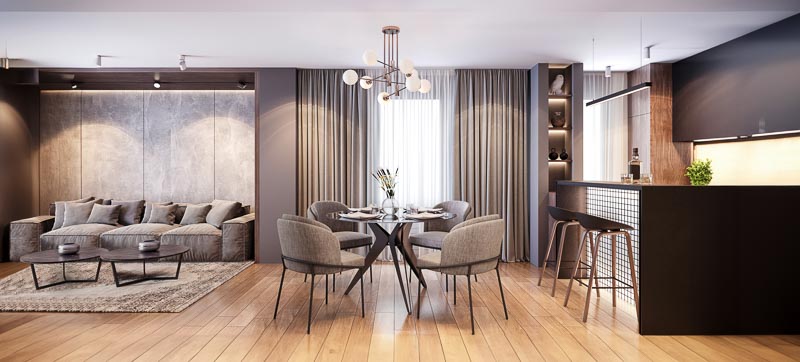
Curtains for everyone
Drapes, curtains, window dressing, call them what you will. They have been described as the “lipstick” of a room’s furnishings; an all-important finishing touch.
Curtains can shut the world out or let the light in. They help set the scene, and in autumn/winter come into their own, adding warmth, ambience, and mood to any room. Colour and pattern are important, and so too are the size and placement of curtains in a room. If you want to make a room look luxurious and high-end, the number one rule is to hang them ceiling to floor, and a bit more besides for an ultra-chic effect.

Hang ‘em high and wide
Curtains look and function best when they are floor length, and there are three options:
- Floating – a finger width of space from the floor to the bottom of the curtain.
- Breaking – a very slight fold or bend just above the hem.
- Puddling – the fabric pools on the floor.
Floating is the easiest to maintain, as breaking and puddling require some fluffing and arranging each time the curtain is moved.
The only time to use short curtains is if there is something below the window that won’t allow floor-length, for instance, a heat source. Try a blind instead.
To add to your high-end look, use statement rods and finials, and embrace layering. Custom-made is an obvious way to achieve a gorgeous end result. Unlimited choice of fabrics, decorative trims, and various pleat options make customised curtain unique to each home.
DIY and ready-made
If you do decide to go the DIY or ready-made route with curtains, fullness is important. Measure the width of your window and multiply that by 2 or 2.5 to calculate the perfect width for appropriate fullness.
The curtain rod should completely cover the window frame and extend past the window. Going wider than the window with the curtain rod makes the window appear wider, and allows the curtains to open across to the wall, instead of in front of the window, allowing allows more natural light into your room.
Colour, texture, and pattern choice is personal, however remember that darker shades will make a larger space cosier. Earthy or bright gemstone-inspired colours, such as rich blues, and autumn hues of brown and gold, create warmth and intimacy, and also absorb light to add a cocooning effect. Tranquil alternatives are warm-toned neutrals, such as beige, cream, and ivory, or nature’s colours of brown, tan, and olive. For drama and luxury, jump to jewel hues such as emerald, garnet, sapphire, and amethyst.
If buying ready-made and they don’t have the exact length that you need, purchase longer curtains and have them hemmed to the correct height.



